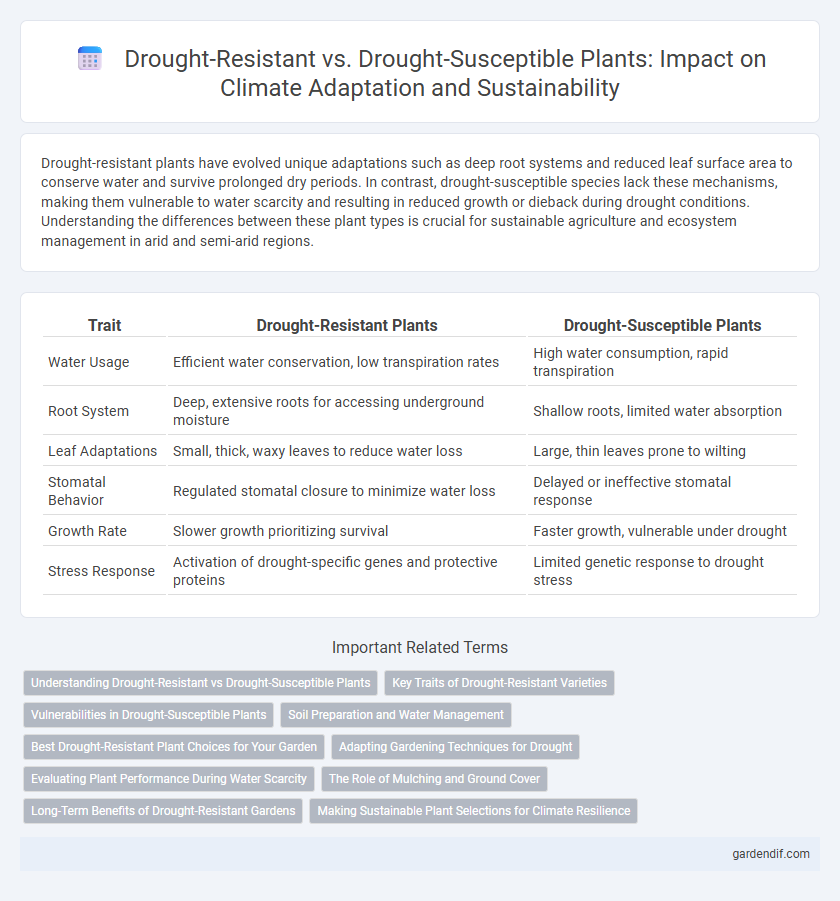
Drought-resistant vs Drought-susceptible Illustration
Drought-resistant plants have evolved unique adaptations such as deep root systems and reduced leaf surface area to conserve water and survive prolonged dry periods. In contrast, drought-susceptible species lack these mechanisms, making them vulnerable to water scarcity and resulting in reduced growth or dieback during drought conditions. Understanding the differences between these plant types is crucial for sustainable agriculture and ecosystem management in arid and semi-arid regions.
Table of Comparison
| Trait | Drought-Resistant Plants | Drought-Susceptible Plants |
|---|---|---|
| Water Usage | Efficient water conservation, low transpiration rates | High water consumption, rapid transpiration |
| Root System | Deep, extensive roots for accessing underground moisture | Shallow roots, limited water absorption |
| Leaf Adaptations | Small, thick, waxy leaves to reduce water loss | Large, thin leaves prone to wilting |
| Stomatal Behavior | Regulated stomatal closure to minimize water loss | Delayed or ineffective stomatal response |
| Growth Rate | Slower growth prioritizing survival | Faster growth, vulnerable under drought |
| Stress Response | Activation of drought-specific genes and protective proteins | Limited genetic response to drought stress |
Understanding Drought-Resistant vs Drought-Susceptible Plants
Drought-resistant plants possess deep root systems, reduced leaf area, and specialized physiological mechanisms like stomatal closure to conserve water, allowing them to survive prolonged dry periods. In contrast, drought-susceptible plants lack these adaptations, leading to rapid water loss, cellular damage, and reduced growth under drought conditions. Understanding these differences aids in selecting suitable plant species for water-scarce environments and improving agricultural resilience amid climate change.
Key Traits of Drought-Resistant Varieties
Drought-resistant varieties exhibit key traits such as deep root systems, enhanced water-use efficiency, and the ability to maintain cellular turgor under water stress conditions. These plants often possess thicker leaves with reduced stomatal density, enabling decreased transpiration rates and improved retention of moisture. Genetic adaptations like osmoprotectant accumulation and efficient antioxidant mechanisms further enhance their survival and productivity during prolonged drought periods.
Vulnerabilities in Drought-Susceptible Plants
Drought-susceptible plants exhibit higher vulnerability due to limited root depth, reduced stomatal regulation, and inefficient water-use efficiency, which impair their ability to maintain cellular hydration during prolonged dry periods. These physiological limitations increase susceptibility to oxidative stress and disrupt photosynthesis, ultimately reducing growth and crop yields under drought conditions. Understanding these vulnerabilities is critical for developing targeted breeding and biotechnological strategies to enhance drought resilience in susceptible plant species.
Soil Preparation and Water Management
Drought-resistant plants require well-amended soil with high organic matter to enhance moisture retention, while drought-susceptible species benefit from soil conditioning that improves aeration and drainage to prevent root rot. Precise water management involves deep, infrequent irrigation for drought-resistant crops to encourage deep root growth, whereas more frequent, shallow watering supports drought-susceptible plants by maintaining surface moisture. Implementing mulching and drip irrigation systems optimizes soil moisture conservation and reduces water waste across both plant types.
Best Drought-Resistant Plant Choices for Your Garden
Selecting drought-resistant plants such as lavender, succulents, and native grasses enhances garden resilience by minimizing water use while maintaining vibrant growth. These species possess deep root systems and adaptive physiological traits that optimize water absorption and retention during prolonged dry spells. Incorporating drought-resistant varieties reduces irrigation needs, conserves soil moisture, and supports sustainable landscaping in arid and semi-arid climates.
Adapting Gardening Techniques for Drought
Drought-resistant plants such as succulents and native grasses require significantly less water, making them ideal for climate-adaptive gardening in arid regions. Incorporating soil amendments like compost and mulch improves moisture retention, reducing irrigation demands on drought-susceptible species. Efficient drip irrigation systems and precise watering schedules optimize water use, ensuring sustainable garden management during prolonged dry periods.
Evaluating Plant Performance During Water Scarcity
Drought-resistant plants exhibit physiological and biochemical adaptations such as deep root systems, efficient stomatal regulation, and osmoprotectant accumulation that enhance survival during prolonged water scarcity. Drought-susceptible species typically show reduced photosynthetic rates, increased leaf wilting, and lower biomass production under the same stress conditions. Evaluating plant performance involves measuring parameters like soil moisture retention, leaf water potential, and chlorophyll fluorescence, which provide critical insights into plant resilience and water-use efficiency under drought stress.
The Role of Mulching and Ground Cover
Mulching significantly enhances soil moisture retention, reducing evaporation rates and providing a protective barrier that benefits drought-resistant plants by conserving water more efficiently than drought-susceptible varieties. Ground cover plants help stabilize soil temperature and reduce surface runoff, creating microclimates that improve drought resilience, especially in arid regions prone to water scarcity. Incorporating organic mulches like straw or wood chips alongside resilient ground covers such as clover or native grasses fosters soil health, promoting root growth and boosting overall plant drought tolerance.
Long-Term Benefits of Drought-Resistant Gardens
Drought-resistant gardens significantly reduce water consumption by utilizing native and xerophytic plants adapted to arid conditions, enhancing soil moisture retention and minimizing irrigation needs. These gardens improve ecosystem resilience, support biodiversity, and lower maintenance costs over time, making them sustainable solutions amidst increasing climate variability. Incorporating drought-tolerant vegetation helps mitigate urban heat island effects and conserves local water resources, offering lasting environmental and economic benefits.
Making Sustainable Plant Selections for Climate Resilience
Drought-resistant plants, such as succulents, native grasses, and certain tree species like mesquite, exhibit deep root systems and water-conserving adaptations that enhance survival during prolonged dry periods. In contrast, drought-susceptible varieties with shallow roots and high water demand require more irrigation and frequent maintenance, increasing environmental strain. Selecting drought-resistant species supports sustainable landscaping by reducing water usage, improving soil health, and promoting long-term climate resilience in vulnerable ecosystems.
Drought-resistant vs Drought-susceptible Infographic

 gardendif.com
gardendif.com